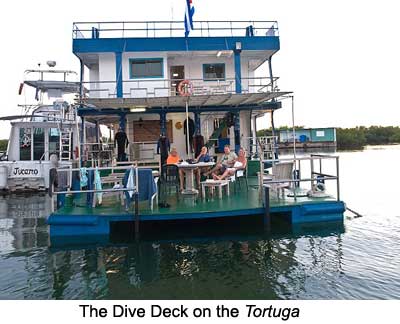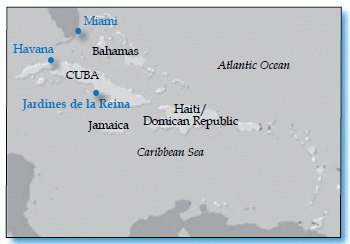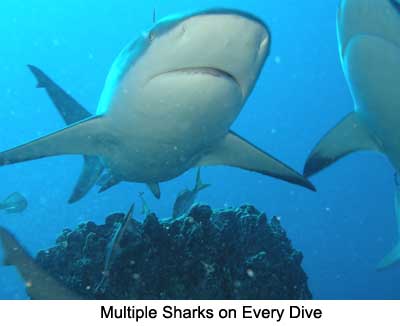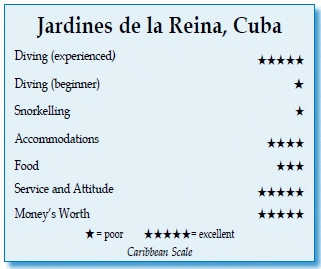Jardines de la Reina, CubaContents of this Issue: Raja Ampat Dive Lodge, Indonesia Improving Rebreather Safety: Part II Is a Caribbean Cruise for Serious Divers? More Etiquette from the Scuba Snobs Anatomy of a Dive Death Investigation One Cavern Plus Panic Equals Four Deaths Books to Make You Smarter Divers This Was a 13-Year-Old’s First Dive Editorial Office: Ben Davison Publisher and Editor Undercurrent 3020 Bridgeway, Suite 102 Sausalito, CA 94965 is it the marine paradise Anderson Cooper claims it to be? from the September, 2012 issue of Undercurrent
Dear Fellow Diver: It was expected to be a dark and stormy night. I awoke to the whistle of wind and a persistent tapping like drops from a rainspout. It was my fourth morning aboard the Tortuga, my Cuban floating hotel, in early March, and El Norte had arrived. Four days before, I had left Havana at 5 a.m. with two American couples aboard a chartered motor coach, and rode for six hours to the port of Jucaro on central Cuba's southern side. Then we had boarded a motor launch for a three-hour journey to the Tortuga, our floating base for the next six days, only to be greeted with the news that an impending storm would require us to dive three times a day instead of two, so that we could get all our allotted dives before the weather closed in.
I geared up on the uncluttered, 22' x 25' aft dive deck, where the only photographer's amenity was a dunk barrel with fresh water. There was a freshwater hose for wetsuit rinsing but no drying rack. All went well until I jammed my left foot into the sleeve of my 3mm full wetsuit. Chinese hand cuffs would have been easier to escape from. I hobbled around and finally fell into a deck chair; four fellow divers politely ignored the fiasco. I untangled myself, stepped into the skiff, and we departed for our checkout dive. Briefed and geared up, I backrolled and descended to a 30-foot-deep flat at Anclitas. I expected the southern side of Cuba, the side that seems to attract most Florida-bound hurricanes, to show some destruction, but the exceptional water clarity, and the health of the sea grass meadows and gorgonians amazed me. It seemed as if every square inch of the reef flat was competing with its neighbor for the nutrient-rich tidal flows. Sea fans were healthy, with perfectly-formed new tip growth, not like the tattered, diseased fans of Bonaire. I followed Fausto, our dive guide, off the flat and down to a sandy level at 60 feet. The photographers studied the bottom for subjects as we moved along a sloped side hill of hard coral. Fausto positioned me so I could be the one to make the discoveries, like a five-inch channel clinging crab, an edible-sized spiny lobster backed into a tight crack, an upright green moray lurking ominously from a series of pillar corals, and a 20-inch-long tiger grouper supporting two remoras.
The skiff's gunwale perfectly matched the dive deck's height. The five of us stepped off while Roberto took our aluminum 80s and BCs to a small island to refill back to 3000 psi (air only). No noise from the compressor or the power generator ever reached our floating hotel. I walked up a stairway to the second floor and the Tortuga's seven cabins. Refurbished in 2008, the upstairs is tiled throughout and has room for 18 guests in a variety of individually controlled air-conditioned room configurations. My wood-paneled cabin, with a double bunk and single bed, had been cleaned by the two young female staffers, and my bed had been made. A large sliding glass window allowed me to sleep bug-free and without air conditioning. I had the choice of 220- or 110-volt outlets to charge my camera and strobe. My gear and clothes alone filled most of the storage space, so I can't imagine sharing the cabin with two others. In my bathroom were a porcelain commode, basin and a tiled shower with a powerful hand-held nozzle. Surface interval over, I dove again and returned for lunch. Noel, the other dive guide, and I talked about the Tortuga's history while we ate. This 25-foot-wide, 100- foot-long wide steel hotel on a barge was built 15 years ago and intended as oil workers' living quarters. It's now run by the Italian Avalon Company and the Cuban Marlin Company, which have an exclusive license for the Jardines De La Reina protected zone, offering fishing and diving trips from the Tortuga and four other liveaboards. Noel has been with this boat from the beginning, working up from laborer to divemaster, and both and he and Fausto speak good English. A day later, he began guiding a group of four Canadians from a separate skiff, not crowding everyone in ours. The lunches and dinners emphasized health and value rather than gourmet deliciousness, and used seasonal local products rather than imports. Shredded cabbage with tomato slices and vinaigrette dressing was the daily salad, and mango chunks and pineapple slices showed up three times daily. The starch choices were white rice, rice and beans, and yucca. Fresh fish lovers will love that snapper, grouper, lobster, and shellfish dominate the meals, and I was able to get red meat or chicken if I requested it.
We usually departed at 3 p.m. for the optional third dive, averaging 70 feet in depth. That was followed by happy hour on the shaded foredeck, where we watched the sunset while a friendly freshwater crocodile watched us, mint leaves were mulled into Mojitos, and multiple plates of pizza and focaccia were passed. Seven of the nine divers were smokers and probably never noticed the diesel smoke floating by as we talked. Beer, non-diet soda and liters of water were $1 each, while wine, liquor, and mixed drinks were offered for $2. The fourth morning arrived, but El Norte's dreaded effects never materialized. The whistle of wind I thought I heard was from my closed cabin window, the tapping of raindrops was actually early-morning maintenance work on a nearby storage barge. Castro's flag had changed directions in response to the slight breeze from El Norte, the temperature had dropped from the normal 82 to 77 degrees, but the sun was rising and the gray clouds were breaking up as three of us boarded and shoved off. The twin 60-hp Yamahas took our narrow, 26-foot skiff through lagoons without a splash, and steeply banked around mangroves close enough to touch. I sat along the side, facing center, with my dressed BC flat on the floor at my feet. Eight divers could be carried comfortably. A small sunshade shielded only the driver and standing dive guide, so sun protection is a must.
I inspected the underside of overhangs with my Sola 1200 compact light. These shadow zones, illuminated by powerful strobes or high-powered handhelds, revealed psychedelic displays of brilliant algae in shades of red, purple, pink and burgundy, with splotches of yellow thrown in, as well as leaf-hanging vine alga and strands of red and purple wire corals. But there were few small reef fish. Unlike Bonaire's variety of butterflies, angels, parrots and chromis, Jardines is infested with squadrons of plump, lazy lionfish. No removal efforts are being undertaken, and they probably would be ineffective. A guided ascent past multiple castles of fuzzy pillar coral ended my dive. Back aboard, a diver said to me, "I notice you don't wear gloves." Fausto replied, "Gloves are prohibited in national parks, but you should wear them here so the sharks don't mistake your white hands for fish." Say what! My hands shriveled back into my wetsuit sleeves as though I'd been doused with ice water. Why wasn't I briefed? The question was answered that evening by Antonio, Tortuga's manager. He admitted he had been taking care of a problem on one of the company's liveaboards for several days, allowing his competent and gracious staff to perform their duties, but not his. We had missed the welcome, C-card check, and briefing completely. He did tell me that the best diving season is from December to April, they never come close to the annual limit of visitors, and he invited me to bring my sling and shoot lionfish next time. Americans willing to accept the challenges and reap the benefits will like diving in Cuba. The diving is not difficult, though one may find the outmoded facilities a little basic. Regardless, I know I will return. Thank you, Anderson Cooper, for highlighting this wonderful place. -- J.J.
|

I want to get all the stories! Tell me how I can become an Undercurrent Online Member and get online access to all the articles of Undercurrent as well as thousands of first hand reports on dive operations world-wide
| Home | Online Members Area | My Account |
Login
|
Join
|
| Travel Index |
Dive Resort & Liveaboard Reviews
|
Featured Reports
|
Recent
Issues
|
Back Issues
|
|
Dive Gear
Index
|
Health/Safety Index
|
Environment & Misc.
Index
|
Seasonal Planner
|
Blogs
|
Free Articles
|
Book Picks
|
News
|
|
Special Offers
|
RSS
|
FAQ
|
About Us
|
Contact Us
|
Links
|
3020 Bridgeway, Ste 102, Sausalito, Ca 94965
All rights reserved.

 On my first morning, I awakened well before the roomservice
coffee delivery to get my system booted and my
gear assembled to avoid any last-minute stress. Then I
joined fellow divers for a continental breakfast, including
eggs and fresh bread (coffee lovers, bring a large
cup). This was to be the standard, but sometimes fresh
cookies or slices of cake were added. Breakfast introductions
revealed one thing we divers all had in common:
We were motivated
to dive Jardines
De La Reina (Queen's
Gardens) because of
Anderson Cooper's
glowing 60 Minutes
report on the place (see the video at
On my first morning, I awakened well before the roomservice
coffee delivery to get my system booted and my
gear assembled to avoid any last-minute stress. Then I
joined fellow divers for a continental breakfast, including
eggs and fresh bread (coffee lovers, bring a large
cup). This was to be the standard, but sometimes fresh
cookies or slices of cake were added. Breakfast introductions
revealed one thing we divers all had in common:
We were motivated
to dive Jardines
De La Reina (Queen's
Gardens) because of
Anderson Cooper's
glowing 60 Minutes
report on the place (see the video at  After I reached 900 psi, I began a slow ascent to a safety stop so I could
breathe down to 500 psi and check my buoyancy. This was not to be. Our bubbles
signaled Roberto, the boat driver, to drop tiny pieces of fish, attracting one,
then three, then five more silky sharks that began circling the boat. The tiny
scraps did not produce the melee I had seen on Mike Ball's Spoilsport when dead
fish were dropped, just a continuous slow circling. For 15 minutes, they gave us
almost every possible angle and pose. The silkies came close enough to touch (I
did) or to observe the sun-lit muscle ridges along their sides as they undulated
past. I checked my buoyancy and found I had overcompensated for my wetsuit. The
consistent 79-degree water would have allowed me to use my 2mm shortie. The
belt weights available were exclusively 1.1 pounds each, which made exact buoyancy
and trim adjustments easy. Once up the vertical ladder, I exclaimed what
a fantastic dive it was. "Just the beginning," said Fausto, "wait for the next
dives." And I knew I had eight more dives before El Norte.
After I reached 900 psi, I began a slow ascent to a safety stop so I could
breathe down to 500 psi and check my buoyancy. This was not to be. Our bubbles
signaled Roberto, the boat driver, to drop tiny pieces of fish, attracting one,
then three, then five more silky sharks that began circling the boat. The tiny
scraps did not produce the melee I had seen on Mike Ball's Spoilsport when dead
fish were dropped, just a continuous slow circling. For 15 minutes, they gave us
almost every possible angle and pose. The silkies came close enough to touch (I
did) or to observe the sun-lit muscle ridges along their sides as they undulated
past. I checked my buoyancy and found I had overcompensated for my wetsuit. The
consistent 79-degree water would have allowed me to use my 2mm shortie. The
belt weights available were exclusively 1.1 pounds each, which made exact buoyancy
and trim adjustments easy. Once up the vertical ladder, I exclaimed what
a fantastic dive it was. "Just the beginning," said Fausto, "wait for the next
dives." And I knew I had eight more dives before El Norte. By the third day, I learned the routine. There were no whiteboards communicating
dive site names, planned depths or attractions. If I saw fish carcasses
in the back of the skiff, it was going to be a shark feed. Twice as many tanks
meant bring sun protection; we were going to off-gas at an island beach. Fausto,
an SSI-certified divemaster with five years' experience at Jardines, followed
routines I was used to: first dives were deep, with an average depth of 102
feet. This was necessary for the deep shark feeds, where a fish carcass was put
into a barrel sponge and covered with several pieces of coral. Reef sharks compete
with groupers, yellowtails and queen triggerfish, all circling for a chance
to stick their heads into the sponge. A great opportunity for over, under, headon
or profile shark shots. Then back to the Tortuga or an island beach for the
surface interval. The second dives averaged 82 feet, and could be another deep
shark feed or an excursion to caverns and a surface feed for silky sharks. Yes,
the emphasis of Jardines is the shark show. More than 80 percent of the dives
were shark-oriented, possibly in deference to the photographers -- or because
I never stepped up and asked for changes of scenery. The depth, duration and
activity did not allow me to depart and follow my own profile unless it was
to ascend for greater safety. On several
dives, I found my aggressive computer indicating
only three or four minutes out of
deco. Fausto was watching and occasionally
motioned me upward.(The nearest decompression
chamber is six hours away in Havana).
By the third day, I learned the routine. There were no whiteboards communicating
dive site names, planned depths or attractions. If I saw fish carcasses
in the back of the skiff, it was going to be a shark feed. Twice as many tanks
meant bring sun protection; we were going to off-gas at an island beach. Fausto,
an SSI-certified divemaster with five years' experience at Jardines, followed
routines I was used to: first dives were deep, with an average depth of 102
feet. This was necessary for the deep shark feeds, where a fish carcass was put
into a barrel sponge and covered with several pieces of coral. Reef sharks compete
with groupers, yellowtails and queen triggerfish, all circling for a chance
to stick their heads into the sponge. A great opportunity for over, under, headon
or profile shark shots. Then back to the Tortuga or an island beach for the
surface interval. The second dives averaged 82 feet, and could be another deep
shark feed or an excursion to caverns and a surface feed for silky sharks. Yes,
the emphasis of Jardines is the shark show. More than 80 percent of the dives
were shark-oriented, possibly in deference to the photographers -- or because
I never stepped up and asked for changes of scenery. The depth, duration and
activity did not allow me to depart and follow my own profile unless it was
to ascend for greater safety. On several
dives, I found my aggressive computer indicating
only three or four minutes out of
deco. Fausto was watching and occasionally
motioned me upward.(The nearest decompression
chamber is six hours away in Havana). The ride showed the unique magic of Jardines De La Reina. I was in a textbook
barrier reef ecosystem 40 miles from Cuba's coast, significantly different
from Bonaire's fringing reef fronting a polluted and rapidly developing coastline. The incoming tide brought very clear water and high visibility to the reef,
while outbound flows from the mangroves reduced visibility, and nourished the
flats backing the hard coral barriers. Approaching the open Caribbean felt like
leaving a protective jade necklace of tiny green islands. After our 12-minute
trip to the mooring buoy at Farallon, Fausto briefed us, Roberto handed me fins,
and lifted my BC and tank, and I backrolled over 10 or 12 (no one was counting
any more) waiting silky sharks. I descended to 85 feet, following Fausto
through tight but sunny, open-roofed passages, and left the group to solo glide
through a maze of contorted, twisting swim-throughs. We met in a box canyon and
reversed our journey, then ascended to yet another surface-interval shark feed.
Once aboard the skiff, I expected a quick return to base, but one of the divers
had dropped his camera when exiting. We were deposited onto an island while
Roberto went off to get fresh tanks, leaving with the admonishment: "If you see a
three-foot iguana, well, it's not an iguana!" I walked the sand, finding pristine
pieces of plastic trash deposited on the shore and washed into the island's dense
foliage. The skiff returned, I boarded, we left, tied up, back rolled, found the
camera and re-did the previous dive at a slower pace.
The ride showed the unique magic of Jardines De La Reina. I was in a textbook
barrier reef ecosystem 40 miles from Cuba's coast, significantly different
from Bonaire's fringing reef fronting a polluted and rapidly developing coastline. The incoming tide brought very clear water and high visibility to the reef,
while outbound flows from the mangroves reduced visibility, and nourished the
flats backing the hard coral barriers. Approaching the open Caribbean felt like
leaving a protective jade necklace of tiny green islands. After our 12-minute
trip to the mooring buoy at Farallon, Fausto briefed us, Roberto handed me fins,
and lifted my BC and tank, and I backrolled over 10 or 12 (no one was counting
any more) waiting silky sharks. I descended to 85 feet, following Fausto
through tight but sunny, open-roofed passages, and left the group to solo glide
through a maze of contorted, twisting swim-throughs. We met in a box canyon and
reversed our journey, then ascended to yet another surface-interval shark feed.
Once aboard the skiff, I expected a quick return to base, but one of the divers
had dropped his camera when exiting. We were deposited onto an island while
Roberto went off to get fresh tanks, leaving with the admonishment: "If you see a
three-foot iguana, well, it's not an iguana!" I walked the sand, finding pristine
pieces of plastic trash deposited on the shore and washed into the island's dense
foliage. The skiff returned, I boarded, we left, tied up, back rolled, found the
camera and re-did the previous dive at a slower pace. Divers Compass: Cuban Diving Centers, the Tortuga's owner, runs
both fishing and diving trips from its liveaboards, and its website
gives excellent suggestions on money matters and getting
there . . . The price runs about $3,630; the cost in U.S. dollars
fluctuates because the package price is in Euros, but it includes
round-trip flights from Cancun to Havana, two nights in a Havana
hotel, the motorcoach and boat launch ride to and from Jardines,
six nights lodging, all meals (including four liters of water and
one Mojito per day), and 12 dives, but no night dives . . . The
flight schedules prevented any tourism, so my shallow impressions of Havana are
lots of neat old cars, quiet streets, grand old hotels, faded glory and no convenience
stores . . . The Cressi rental equipment seemed in very good shape .
. . I was told oxygen and first-aid kits were on the skiffs, and the drivers
were in touch with base by marine radio and cell phone . . . It is illegal for
Americans to spend money in Cuba, and the moment of truth occurs when presenting
your CBP form 6059B to the Customs agent upon return to the U.S., so omit listing
Cuba; if you are asked if you visited another country than Mexico, you must
say yes, but you don't have to incriminate yourself by stating you spent money
there . . . Minimize the risk by obtaining a GOES pass (
Divers Compass: Cuban Diving Centers, the Tortuga's owner, runs
both fishing and diving trips from its liveaboards, and its website
gives excellent suggestions on money matters and getting
there . . . The price runs about $3,630; the cost in U.S. dollars
fluctuates because the package price is in Euros, but it includes
round-trip flights from Cancun to Havana, two nights in a Havana
hotel, the motorcoach and boat launch ride to and from Jardines,
six nights lodging, all meals (including four liters of water and
one Mojito per day), and 12 dives, but no night dives . . . The
flight schedules prevented any tourism, so my shallow impressions of Havana are
lots of neat old cars, quiet streets, grand old hotels, faded glory and no convenience
stores . . . The Cressi rental equipment seemed in very good shape .
. . I was told oxygen and first-aid kits were on the skiffs, and the drivers
were in touch with base by marine radio and cell phone . . . It is illegal for
Americans to spend money in Cuba, and the moment of truth occurs when presenting
your CBP form 6059B to the Customs agent upon return to the U.S., so omit listing
Cuba; if you are asked if you visited another country than Mexico, you must
say yes, but you don't have to incriminate yourself by stating you spent money
there . . . Minimize the risk by obtaining a GOES pass ( 